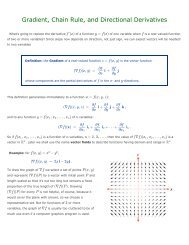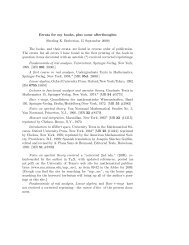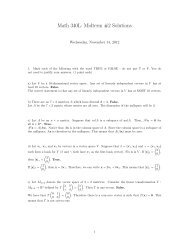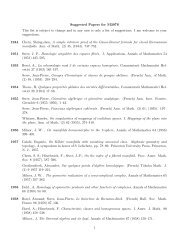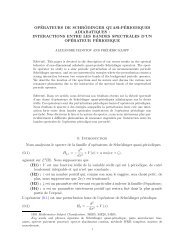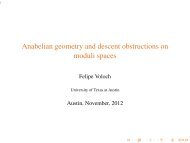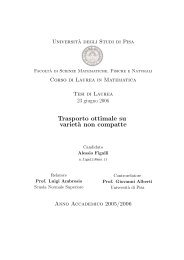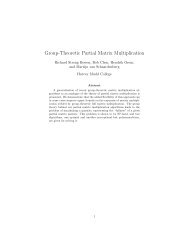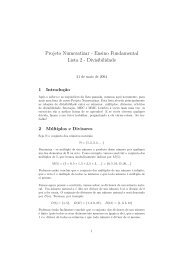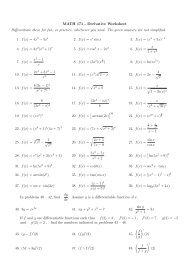Optimal transport, Euler equations, Mather and DiPerna-Lions theories
Optimal transport, Euler equations, Mather and DiPerna-Lions theories
Optimal transport, Euler equations, Mather and DiPerna-Lions theories
Create successful ePaper yourself
Turn your PDF publications into a flip-book with our unique Google optimized e-Paper software.
3.1. THE DIMENSION OF THE MATHER QUOTIENT 37<br />
for any x, y, z ∈ M, <strong>and</strong> therefore it also satisfies the triangle inequality<br />
h(x, z) ≤ h(x, y) + h(y, z).<br />
Moreover, given a weak KAM solution u, we have<br />
u(y) − u(x) ≤ h(x, y), ∀ x, y ∈ M.<br />
In particular, we have h > −∞ everywhere. It follows, from the triangle inequality, that the<br />
function h is either identically +∞ or it is finite everywhere. If M is compact, h is finite<br />
everywhere. In addition, if h is finite, then for each x ∈ M the function hx(·) = h(x, ·) is a<br />
critical viscosity solution. The projected Aubry set A is defined by<br />
A = {x ∈ M | h(x, x) = 0}.<br />
As done by <strong>Mather</strong> (see [60, page 1370]), one can symmetrize h to define the function δM :<br />
M × M → R by<br />
∀x, y ∈ M, δM(x, y) = h(x, y) + h(y, x).<br />
Since h satisfies the triangle inequality <strong>and</strong> h(x, x) ≥ 0 everywhere, the function δM is<br />
symmetric, everywhere nonnegative <strong>and</strong> satisfies the triangle inequality. The restriction δM :<br />
A × A → R is a genuine semi-distance on the projected Aubry set. We call this function δM<br />
the <strong>Mather</strong> semi-distance (even when we consider it on M rather than on A). We define the<br />
<strong>Mather</strong> quotient (AM, δM) to be the metric space obtained by identifying two points x, y ∈ A if<br />
their semi-distance δM(x, y) vanishes (we mention that this is set is also called quotient Aubry<br />
set). When we consider δM on the quotient space AM we will call it the <strong>Mather</strong> distance.<br />
3.1 The dimension of the <strong>Mather</strong> quotient<br />
In [62], <strong>Mather</strong> formulated the following problem:<br />
<strong>Mather</strong>’s Problem. If L is C ∞ , is the set AM totally disconnected for the topology of δM,<br />
i.e. is each connected component of AM reduced to a single point?<br />
In [61], <strong>Mather</strong> brought a positive answer to that problem in low dimension. More precisely,<br />
he proved that if M has dimension two, or if the Lagrangian is the kinetic energy associated to<br />
a Riemannian metric on M in dimension ≤ 3, then the <strong>Mather</strong> quotient is totally disconnected.<br />
<strong>Mather</strong> mentioned in [62, page 1668] that it would be even more interesting to be able to prove<br />
that the <strong>Mather</strong> quotient has vanishing one-dimensional Hausdorff measure, because this implies<br />
the upper semi-continuity of the mapping H ↦→ A.<br />
In [9], in a joint work with Albert Fathi <strong>and</strong> Ludovic, we were able to show that the vanishing<br />
of the one-dimensional Hausdorff measure of the <strong>Mather</strong> quotient is satisfied under various<br />
assumptions. Let us state our results.<br />
Theorem 3.1.1 If dim M = 1, 2 <strong>and</strong> H of class C 2 or dim M = 3 <strong>and</strong> H of class C k,1 with<br />
k ≥ 3, then the <strong>Mather</strong> quotient (AM, δM) has vanishing one-dimensional Hausdorff measure.



